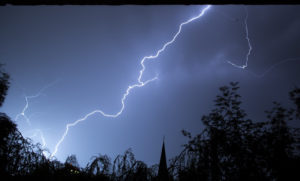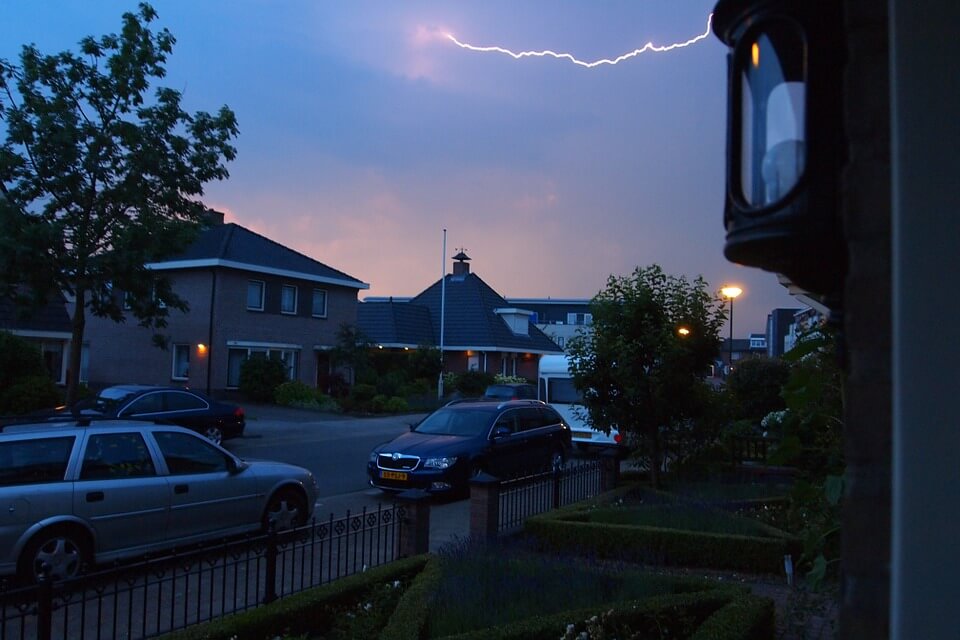What to Look for When Inspecting Your Roof After a Severe Storm

Once a storm passes, it’s important you inspect your roof and make note of any problems so you can take steps to get them fixed:
1. Check Inside Your Home for Evidence of Leaks from Your Roof
When looking inside your house, keep an eye out for:
- Water stains on your walls and ceilings.
- Moisture dripping or pooling in your attic.
- Waterlogged light fixtures.
- Peeling or bubbling paint on your walls.
- Unexplained water inside, whether puddles on the floor or drips from the ceiling.
Stopping a leak should be a priority repair. Work with an experienced roofer to find and fix the damage to prevent the problem from getting worse and causing more harm down the road.
To learn more about how to spot and avoid storm-chaser roofers, click here.
2. Inspect Your Roof for Signs of Storm Damage
While checking out your roof, be on the lookout for:
- Dented or chipped shingles, which could be a sign of hail damage. You should also be vigilant for cracked or curled shingles that will need to be replaced before the next storm hits.
- Loosened flashings and fasteners. If these weak spots aren’t sealed, they can let water seep in.
- Damaged sealing strips. This can be harder to spot, as shingles often simply settle back into place after a storm even if the sealing strip isn’t intact. If the sealing strip has been damaged, it won’t act as an effective moisture barrier and will ultimately lead to leakage.
For your own safety, you should not climb on your roof yourself. Especially after a storm, shingles might be slippery and the roof’s structure weakened in spots. Always contact an experienced roofer to thoroughly assess your roof. They will have the training and skill to examine your roof safely and advise you on any necessary repairs.
3. Ensure Eavestroughs are Clear of Debris
Do you notice your eavestroughs seem to be filled with leaves? Are there twigs poking out? Is there any other debris like mud? It’s important to clean your eavestroughs promptly so that when the next storm hits, they’ll have no trouble moving water away from your home.
Remember to also keep an eye out for granules from shingles in your eavestroughs. When intact, they protect shingles from the sun’s damaging UV rays and general wear-and-tear.
4. Take a Look Around Your Property for Hazards
After a storm goes by, walk the perimeter around your home to find any signs of damage like dislodged shingles or snapped branches:
- If you come across loose shingles, contact an experienced roofer to assess your roof and make any necessary repairs or replacements.
- Assess where downspouts are directed. If high winds or heavy rains have caused them to shift and move water directly towards your home’s foundation, redirect them so water will flow away.
- If you find a downed tree – whether it’s fallen on your roof or your lawn – you need to contact a professional contractor to remove it and assess the damage caused.
What Should You Do if a Storm Damages Your Roof?
1. Contact Your Insurance Agent
After assessing the damage to your roof and home, contact an insurance agent who can help you determine whether or not you should file a claim. Read your coverage details carefully before calling to confirm whether or not your policy covers wind damage.
If you need to undertake emergency repairs to prevent further harm, make sure you keep all the receipts. Insurance companies will want to see evidence you took action to stem the problem and – in some cases – will reimburse your costs.
2. Inquire About Warranties on Your Roofing Materials
Warranties offer homeowners additional protection when unforeseen or uncontrollable events come up, though each manufacturer will have their own coverage levels. GAF, for example, offers a warranty that will cover winds up to 130mph (or about 210 km/h), except on 3-tab shingles.
3. Find an Experienced Roofer
To make sure your roof is ready when the next storm rolls into town, you need to work with an experienced roofer to guarantee long-lasting results.
Remember, don’t allow a door-to-door roofer who arrives after a storm onto your roof. Often these “storm-chasing” roofers are nothing more than scam artists likely to damage your roof while working on it, use low-quality materials, or disappear after getting your deposit.
At Herb Lodde and Sons, our experienced roofers have been providing roofing repairs and replacements for over 50 years. Contact us now to schedule an in-home consultation!
Like this? You might also like:

